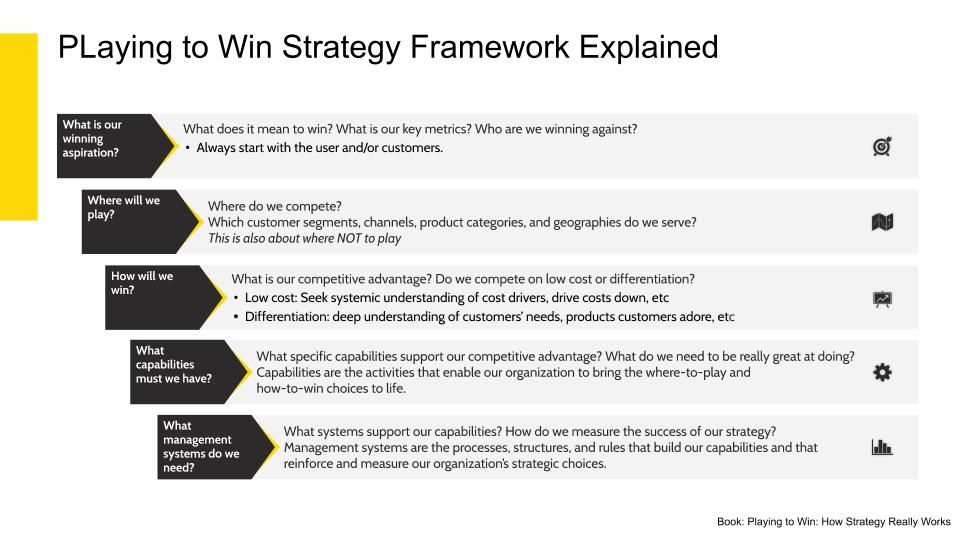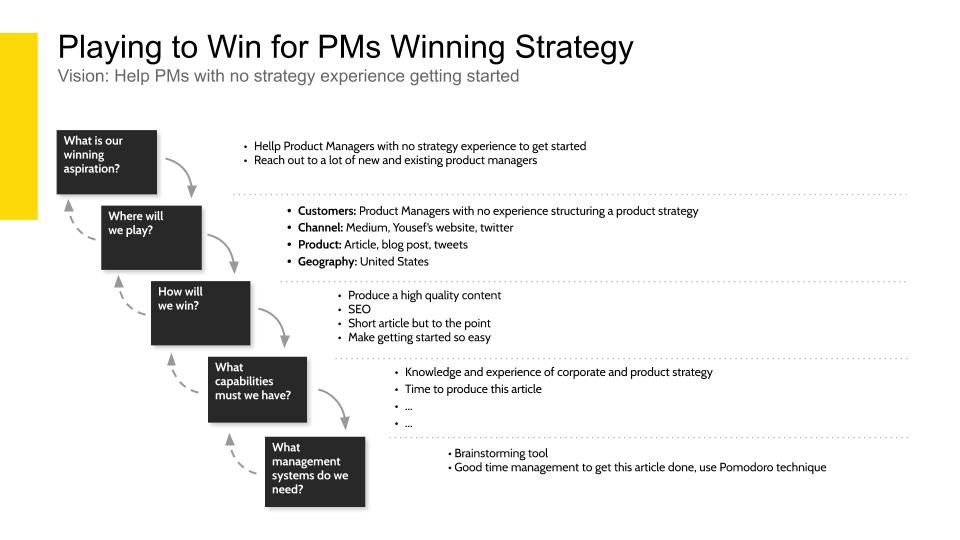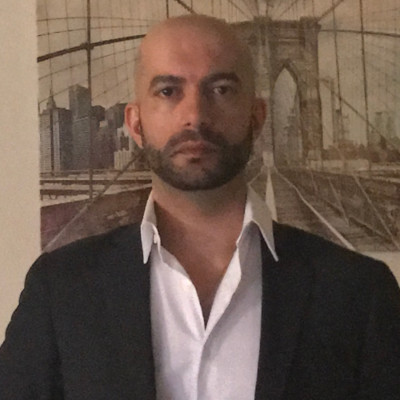Playing to Win Strategy for Product Manager
- August 17, 2020
- Posted by: Yousef Ghandour
- Category: Business Tips, Corporate

One of the strong strategy frameworks I used is Playing to Win. I liked it because it is well structured and forces me to answer very specific questions.
Product managers should own the product vision, strategy, and execution. That said, what I observed working with a lot of product managers is that they spend 99% of their time executing on features. From collecting requirements to understanding data and the user to writing specifications consume most if not all of their time.
If you don’t have time to think strategically about your product, if you are constantly chasing new features and reacting to changes or prioritization, then this article will help you start thinking strategically about your product.
Introduction
Simply put, this is an easy way on how to quickly structure your product vision, strategy, and execution. It will get you thinking and will give you a way to share your vision and strategy. It is a good starting point.
What is Product Strategy?
Strategy is about making specific choices to win in the marketplace — A.G. Lafley
Product strategy is a high-level plan that helps you realize your vision. It is a set of choices that you will make to create and capture value. Winning is key here, and that is why defining what winning is critical.
There are four main important components of any successful product
- Product Vision
- Product Strategy
- Product roadmap
- Product Backlog and Execution
Playing to Win, a simple framework that can help you structure your product strategy in hours

Playing to win is a cascade of five main choices
- What is our winning aspiration?
- Where will we play?
- How will we win?
- What capabilities must be in place?
- What management systems are required?
Process
- Create your strategy (Playing to Win strategy) for your product. At this point, you don’t have a lot of data or even feedback, just write down what you think is correct based on your understanding. Use your corporate strategy if you have one to guide you through the choices you want to make.
- You might want to create multiple ones if you have more than one strategy. This is a good practice if you are doing this for the first time and you don’t yet know which strategy you want to adopt.
- Gather some feedback from your manger and colleagues
- Reverse Engineering: Ask what must be true in order for this strategy to be a set of winning choices? What conditions must be met? What are the potential barriers to success?
Create your first Playing to Win Product Strategy
I’ve created this Google Slides template for you. Below is a preview
To help you through out creating your first Playing to Win Product Strategy, I made up a new product idea: This post.

It took me less than five minutes to structure my product strategy for this post. It is a very simple structure that will get you thinking about what is important and what is not. Strategy is about making tough choices, it is about what you will not do as much as it is for what you will do.
What is our winning aspiration?
This could you be your product vision or long term goals. Sometimes I structure those using OKRs, but not at this level. Please note that this is not your company winning aspirations, it is your product winning aspirations. For example, your company might want to double the number of subscribers, your winning aspirations could be a proxy to get to that, but not directly. If you are focused on user experience, for example, then improving the referral process might be a good winning aspiration. Always think in term of your product.
Where will we play?
A lot could be said about segmentations here. That said, keep it simple at this point. This should be all or a subset of the corporate target markets. List the type of customers, the channels on how to reach them, the products you are building for them and any geography constraints. If you use the Business Model Cavs, it could be great to fill in the blanks here.
How will we win?
This is important, and most of the time, it is a list of hypothesis. State clearly how you will win in the market place. A good start could be to understand your competitive landscape and what your competitors are offering. It is also important to understand where you stand, and whether you are leading the industry or not. Clearly identify the things that you will do to win, and the things that you will NOT do.
What capabilities must we have?
Capabilities is a hard thing to build and acquire. In might be something you possess at the moment, or something you need to build or acquire to be able to execute on this strategy. In one company I worked with, one of the capabilities was a deep understanding of the customers. Back then, we didn’t have any data strategy (quantitative research) to help us achieve that, so the data strategy became one of the most important initiatives. It took us more than two years to get to a point where we could say we have good understanding of our customers.
What management systems do we need?
This is more important for corporate strategy than product strategy. That said, and in some cases, if you don’t have a mature process and management systems in place, it is vital to state that clearly here. For example, do you collect NPS from your customers? Do you have a mature agile process by which you can deliver consistently on your new initiatives? What management systems you need in place to be able to successfully execute on this strategy?
Reverse Engineering
This is an amazing approach to problem solving in general. Here you are using a hypothesis based approach as opposed to researching everything. Based on your answers, you can focus your research to get results fast.
Please note that you can find a lot of answers in your corporate strategy.
Wrapping up
Playing to Win is a powerful yet simple strategy framework. It can help you start the thinking about your product vision and strategy. It will make prioritization of features a little bit easier and will help you lead your team(s).
Please do the following next week:
- Please block an hour next week to go through this exercise, it is not hard at all
- If you don’t find time during the week, make it a habit. Block a three hours weekly on your calendar and call it Strategic Block. Ask your manager and colleagues to respect it
- For your strategic block, get out of the office (if you are not currently working from home)
- Go through the process once
- Gather feedback from your colleagues
- Send me your feedback please
Resources
- Playing to Win: How Strategy Really Works by A.G. Lafley
- Playing to Win: How Strategy Really Works by Yousef Ghandour


